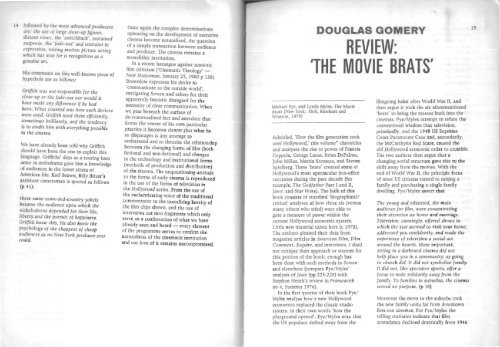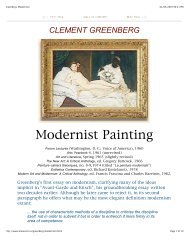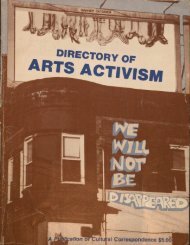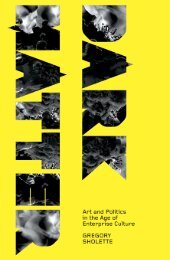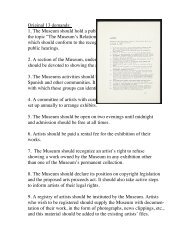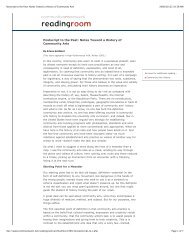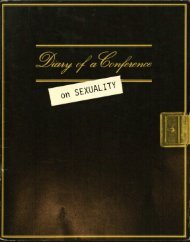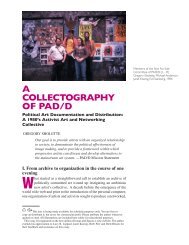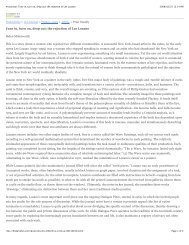12 of leading characters. No longer is itpossible for us to dismiss the silentcinema. 'The magic of cinema' isenhanced. and our position as audiencewillingly implicated in the spectacles ofHollywood is confirmed. If anything wemay even feel a tinge of nostalgic regretthat those of us socialised to thef\inemalic experience through thehumdrum dramas of more recent yearsmay have missed Out on the more intensepleasures of our grandparents in thepicture palaces of yesteryear.The V and A exhibition poses slightlydifferent problems from those of thetelevision series - problems whichaccrue around the apparently contradictorynotions of authorship, and of film as a'collaborative art'. Rather than attemptingto introduce us to new possibilities ofcinematic spec(tac)ularit}', it took itsaudiences, assumed love of the cinemafor granted. co ncentrating ~on tried andtested memories of contemporary filmgoers. So there were rooms dedicated tothe movies that do good business inrevival houses - the 1930's musicals. thefilm noir - as well as all -time classicsof the screen - Intolerance, Gone with(he Wind and Citizen Kane, for example.In these rooms we were enjoined todiscover the talents of the art directors ofHollywood. In the pantheon of pleasurethe names of such 'forgotten figures ' asRichard Day, Anton Grot and Van NestPolglase can be added to those of Griffith ,Welles and Berkeley.Perhaps it is too much to expect the\....a1ls of the V&A or a peak-time televisionslot to be the sites of any historicalanalysis of how the cinema in Americamoved from being a minor fairgro undattraction to a vertically integrated,effective ly self-regulating major industrywith an annual investment of about oneand a half billion dollars, in a little lessthan twenty years. Perhaps it is also naive and idealistic to expect a television company to inaugurate any but the most superficial examination of the mechanics of visual pleasure and specularity in thecinema. The ramifications of this might befelt not only in the ratings. Obviously, thehistory of Hollywood as an industrycannOt be viewed in isolation from thewhole history of finance capital in theUSA. The investment in the possibility ofpleasure that the banks and big businessundertook in the early decades of thiscentury had directly determining effectson the fictional forms produced byHollywood. No simple relationship canof course exist between investments ofcapital and the pleasures of the audience.However, the way in which the Thamesseries continually skirts these issues doesnothing to make public knowledge of thedevelopment of Hollywood any more'historical' than it already is, and it isnot merely bad faith or academic gripingto insist on the necessity of the wri6ngof this history.Let us take a concre te example oferror by omission. In the third programmeof the series we were given an accoun[ ofa series of scandals in Hollywood which led to the eventual formation of the Motion PicnlCe Producers and Distributorsof America, the appointment of Will Haysas the 'moral watchdog' of the industry,and the establishment of a codecontrolling the coment of motion pic[Ures. The show presents this as a simple ideological decision: public outcryat the excesses of the stars' private livesand the films' treatment of sex andviolence results in the formation of aninstitution to curb these tendencies. Therealhy would, however. appear to bemuch more complicated. The majorstudios who formed the MPPDA welcomedthe opportunity for self-regulation, as thisprovided effective security of investmentand consolidation of control for thebanks who by that time had gained theeconomic whi p-hand in Hollywood, At thesame time, profiting from the economicchaos in Europe after the firsr world war.Hollywood was supplyi ng more and morefi lms for the world market. Theestablishment of the Hays Code ensuredthe industry's freedom from outsidecensorship by either state or federalgovernments. Similarly, the establishmentof the Code ensured that the studiosacquired a stranglehold over the outletsfor distribution throughout the States,The cinema becomes a much saferinvestment than, say, the press or radio.Perhaps even more important are [heeffects the Hays Code had on thedevelopment of fictional forms. This is,of course. easily determined withreference to content - American filmsfor [he European market continue to bemore sexual1y explicit. in terms of theexhibition of the female body, forexample. than the versions released onthe home market. Much more difficul t todetermine with any precision, and muchmore interesting, is the effect that, forexample, the 'control of sexualiry' exertedby the Code had on the organisation ofnarrative, We need only think of thetremendous weight given to marriage asan effective fo rm of closure in the classicHollywood fil m, and the narrativecomplexity generated by the repressionof the erotic, focus of much of theprogressive film theory generated inrecent years.It is in regard to the in vestment in anddevelopment of certain fictional forms.certain conventions of narrativeorganisation. that the series is lamentablydeficient_ In its incessant need to reclaimthe silent cinema as a popular an whichwas at least, if not more, technica lJyinventive, than its contemporarycounterpart. the most pertinent questionsare jettisoned in advance. \"'hat emergesis a fami li ar pattern : the 'natural' or'universal' language of the cinema liesdormant. presen-t from (he s tart in thetechnology, merely waiting to be draw nout by the appropriate pioneer. Thediscovery of this natural language,'Esperanto for the eyes' as Brownlowcalls it, becomes a process of trial anderror - the experiments of the pioneersare either sanctioned or not b)' theaudience:And if the experience took you out ofyourself and fltriched you, you talkedabout it to }'our friends, creating theprecious 'word of mouth' publicity thattile industry depended upon. You mayhave exaggerated a little. but the moviesSOon matched your hyperbole. Theytl'olved to meet the demands of theiraudience. (Preface, p 7)So one glaring omission of the seriesso far is the lack of any account of thedevelopment of the standard shotsequences to forms of narrative. Twobrief examples will suffice. The famoussequence from The Great Train Robbery(1903) in which the gang-leader fires hisgun directly out of screen is merelyaccompanied by the commentator'sassurance that this shot made theaudience feel more involved in the drama.So although 'primitive', Porter's workbecomes 'pure cinema'. What is howevermuch more in teresting about this 'famousfirst' is the fact that it has no place inthe narrative of rhe fil m at al l. Rapidlythe Hollywood cinema would developconventional forms such as the 30-degreerule which would ensure that thepossibiliry of breaking the spell ofcollusion betw'een audience and diegesiswould be severely curtailed. As NoelBurch makes cl ear in his discussion ofPorter (,Porrer, or Ambivalence', <strong>Screen</strong>Winter 1978/9 vol 19 no 4) rather thanthis shot being central in the developmentof the natural language of the cinema,it was in fact radically eccentric. So muchso tha t {he shot was delivered toexhibitors on a separate reel: 'it wasup to the exhibitors to decide whetherto stick it on at the beginning or end ofthe filin: Secondly, in the discussion ofGriffith (p 62) , Brownlow quotes from aBiograph advertisement :ltl cluded in the innovations which heintroduced and which are now generally13
14 lollowed by the most advanced producersare: the use 01 large close-up figures,distant views, the 'switchback', sus tainedsuspense , the 'lade-out' and restraint inexpressiotl. raising motion picture actingwhich has Won for it recognition as agenuine art.His comments on this weU~known piece ofhyperbole are as follows :Griffith was "ot responsible lor theclose-up or the lade-out nor would ithave made any difference il he hadbeetl. l1'hat counted was how such deviceswe re used. Griffith used them efficiently,sometimes brilliantly, and the ten dencyis to credit him with everything possiblein the cinema.We have already been told why Griffithshould have been the one to explOit thislanguage. Griffiths' days as a touring hamactor in melodrama gave him a knowledgeof audiences in the lower strata ofAmerican life. Karl Brown, Billy Bitzer'sassistant cameraman is quoted as fcHows(p 41):these same town-and-country yokelsbeca me the audietlCe upon which thenickelodeons depended lor their lile, liberty a"d the pursuit 01 happi"ess, Griffith k"ew th is. He also knew the psychology 01 the cheapest 01 cheap audietlccs as no New York producer evercould,Once again the complex determinationsoperating on the development of narrativecinema become naturalised, the questionof a simple transaction between audienceand producer. The cinema remains amonoJithic institution.In a recent harangue against semioticfilm criticism (,Cinematic Theology' _New Statesman, January 25, 1980 P 138)Brownlow expresses his desire to 'communicate to the Outside worJd', castigating <strong>Screen</strong> and others for their apparently fascistic disregard for rhenecessity of clear communication. Whenwe peer beneath the surface ofde-contexuaHsed fact and anecdote thatforms the veneer of his own particuJarprac tke it becomes clearer +hat what heso disparages is any attempt toundersrand..and to theorise the relationshipbetween the cbanging forms of film (both fictional and non-fictional) and changes in the technology and ins titutional forms(metbods of production and distribution) of the cinema. The unquestioning anirude to the forms of early cjnema is reproduced in the use of the forms of television in the Hollywood series. From the use ofthe authentica ting voice of the traditionalcommentator to the tantalising brevi ty ofthe film clips shown, and the use ofinterviews cu t into fragmen ts which onlyserve as a confirma tion of what we havealready seen and heard - every elementof the programme serves to confirm thenaturalness of the cinematic institutionand our love of it remains uncompromised.DOUGLAS GOMERYREVIEW: 'THE MOVIE BRATS' Mich:lel Pye, and Lynda Myles, The MovieBrats (New York: Holt, Rineha rt andWinston, 1979)Subtitled, 'How the film generation tookover Hollywood,' this volume" chroniclesand analyses the rise to power of FrancisCoppola, George Lucas, Brian DePalma,John Milius, Martin Scorsese, and StevenSpielberg. Tbese 'brats' created some ofHollywood's most spectacular box,officesuccesses during tbe past decade (forexample, The Godlather Parr 1 and II,Jaws, and Star Wa rs). The bulk of thisbook consists of standard 'biographical!critical' analyses of how these six (versusmany others who tried) were able togain a measure of power within tbecurrent Hollywood economic system.Little new material exists here (c 1978).The authors gleaned their data frommagazine articles in American Film, FilmComment, Esqu ire, and interviews. I shallnot critique their approach or sources forthis portion of the book; enough hasbeen done with such methods in <strong>Screen</strong>and elsewhere (compare Pye/ Myles'analysis of Jaws (pp 223-228) withStephen Heath's review in Frameworkno 4, Summer 1976).In the fi rsr quarter of their book Pye/Myles analyse how a new Holl ywoodeconomics replaced the classic studiosystem. in their own words 'how theplayground opened'. Pye/ Myles note thatthe US populace drifred away from thefilmgo ing habit after Worl d War II, andthen argue it took the six aforementioned'brats' to bring the masses back into thecinemas. Pye/Myles attempt to refute theconventional wisdom that television,principall y, and the 1948 US SupremeCourt Paramount Case and, secondarily,the McCarthyite Red Scare, caused theold Hollywood economic order to crumble.The two authors then argue tha t achanging social structure gave rise to theshift away from the movies. With theend of World War II, the principle focusof most US citizens turned to rais.ing afamil y and purchasing a single familydwelling. Pye/Myles assert thatThe young a"d educated, the mainaudience for film, were concen tra tingtheir attention on home and marriage.Television. cunningly. offered shows inwhich the star seemed to visit your home,addressed you confidently, and made theexperience of television a social actaround the hearth. More im portant.sitting in a darkened cinema did nothelp place you in a community, as goingto church did. It did not symbolize fa mily.It did not, like spectator sports, offer afo cIls to male solidarity away from Olefam ily. To families in suburbia. the cinemaserved no purpose. (p 18)Moreover the move to the su burbs tookthe new family un its fa r fro m downtownfirst-run cinemas. For Pye/Myles therelling statistics indicate that fil mattendance decl ined drastically from 194615


